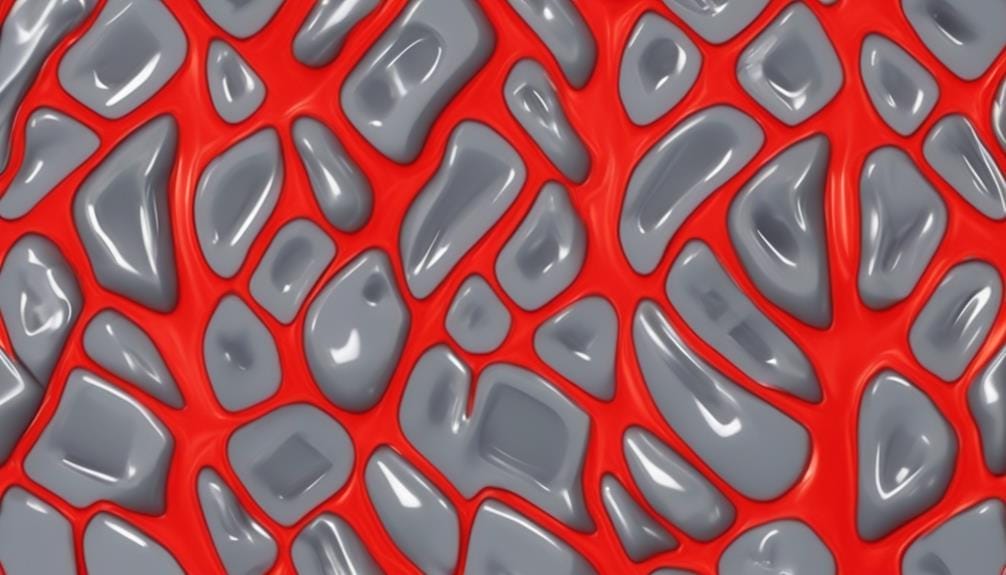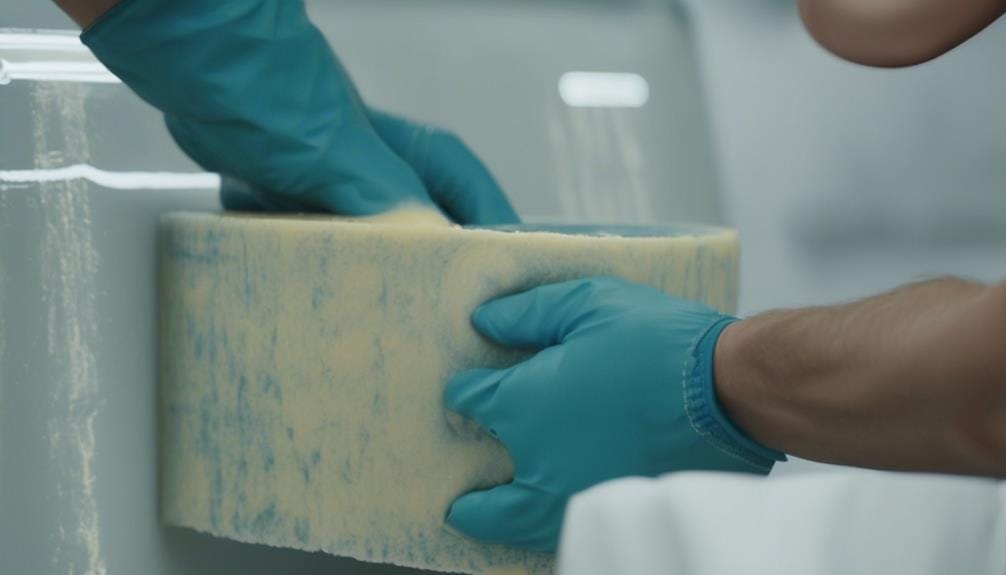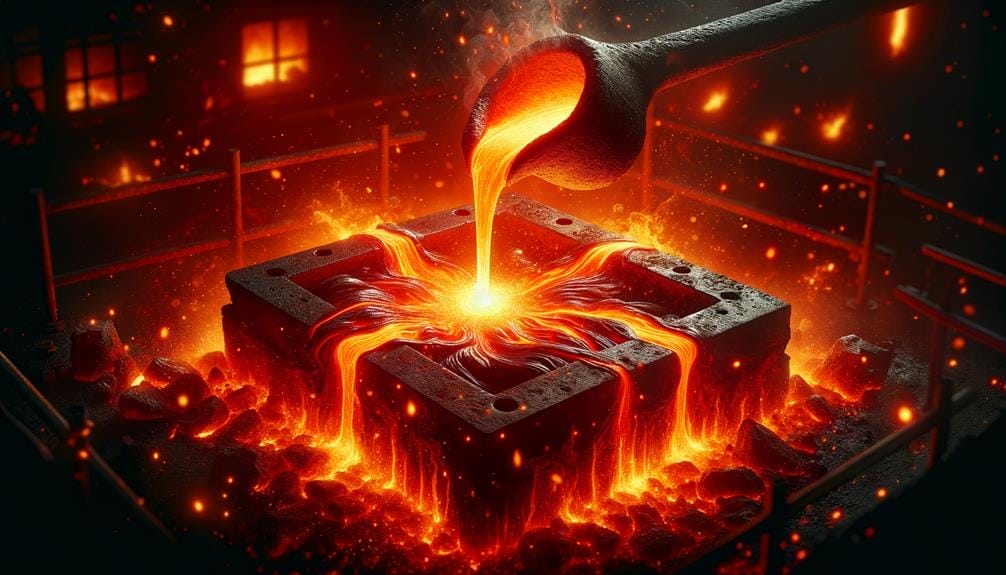Did you know that heat resistant epoxy is capable of withstanding temperatures up to 200°C or 390°F? This remarkable statistic highlights the impressive capabilities of this adhesive in high-temperature environments.
Whether you’re a professional in an industrial setting or a homeowner looking to tackle heat-related repairs, heat resistant epoxy offers a reliable solution. But what makes it so special? And how can you ensure you choose the right epoxy for your needs?
In this discussion, we will explore the benefits, applications, and key features of heat resistant epoxy, providing you with the knowledge and insights you need to make informed decisions.
So, let’s dive into the world of heat resistant epoxy and discover why it is a must-have for various heat-resistant applications.
Key Takeaways
- Heat resistant epoxy can withstand temperatures up to 200°C or 390°F, providing structural strength in high-temperature environments.
- It is a versatile adhesive, encapsulant, or potting compound, suitable for materials like carbon fiber and fiberglass.
- The epoxy exhibits toughness, adhesion, compressive strength, and flexural modulus, making it reliable for various industrial applications.
- It offers long pot life at room temperature and short heat cure time, making it convenient for projects with time constraints.
Benefits of Heat Resistant Epoxy
Heat Resistant Epoxy offers a multitude of benefits, making it an exceptional choice for high-temperature applications. With its ability to provide structural strength at temperatures as high as 200°C or 390°F, this epoxy is perfect for environments that experience extreme heat. Its versatility allows it to be used as an adhesive, encapsulant, or potting compound, making it suitable for a wide range of materials, including carbon fiber and fiberglass.
One of the key advantages of Heat Resistant Epoxy is its exceptional mechanical properties. It exhibits toughness even at high temperatures, ensuring the structural integrity of the application. Additionally, it possesses good adhesion, compressive strength, and flexural modulus, making it reliable and durable in high-heat environments. Furthermore, this epoxy demonstrates excellent chemical and water resistance, adding to its overall reliability.
Heat Resistant Epoxy also offers user-friendly features. It has a long pot life at room temperature, allowing for easy handling and application. The relatively short heat cure time saves time and increases efficiency during the curing process. Moreover, this epoxy has high impact resistance, ensuring the application’s durability even under high-heat conditions. Lastly, it’s low in odor and toxicity, providing a safe working environment.
Applications in Industrial Settings
In industrial settings, the heat resistant epoxy, MAX HTE A/B Resin System, offers numerous applications and advantages.
It can be used as an adhesive, encapsulant, or potting compound, providing structural strength at temperatures up to 200⁰C or 390⁰F.
With exceptional toughness, good adhesion, and excellent chemical resistance, it’s suitable for vacuum-assisted resin transfer molding (VARTM), fiber pultrusion, and other industrial processes.
Industrial Uses
MAX HTE A/B Epoxy Resin System is a versatile and durable option for various industrial applications. Its exceptional toughness and excellent chemical and water resistance make it a popular choice. It is especially suitable for high-temperature environments as it provides structural strength at temperatures up to 200⁰C or 390⁰F.
This heat-resistant epoxy is commonly used as an adhesive, encapsulant, or potting compound in industrial settings. It can be modified with fillers and colorants to meet specific requirements. Additionally, its compatibility with vacuum-assisted resin transfer molding (VARTM) and fiber pultrusion processes expands its industrial applications.
In terms of convenience and efficiency, the epoxy resin system offers a long pot life at room temperature and a relatively short heat cure time. This makes it ideal for industrial applications that have specific time constraints.
Benefits and Advantages
With exceptional toughness and reliable mechanical properties at high temperatures, the MAX HTE A/B Epoxy Resin System offers numerous benefits and advantages for industrial applications.
- Enhanced heat resistance: The epoxy resin system can withstand temperatures up to 200⁰C or 390⁰F, making it ideal for industrial processes that require high heat resistance.
- Reliable mechanical properties: MAX HTE A/B Epoxy Resin System exhibits exceptional toughness, good adhesion, compressive strength, and flexural modulus, providing reliable mechanical properties in various industrial settings.
- Versatility and convenience: This heat resistant epoxy can be used as an impregnating resin, adhesive, encapsulant, or potting compound, making it suitable for a wide range of applications. It also offers a long pot life at room temperature and a relatively short heat cure time, providing convenience and efficiency in industrial processes.
With its heat resistance, reliable mechanical properties, and versatility, the MAX HTE A/B Epoxy Resin System proves to be advantageous for numerous industrial applications.
Heat Resistant Epoxy for Home Repairs

When using heat resistant epoxy for home repairs, there are several important points to consider.
Firstly, understanding the various uses of heat-resistant epoxy is crucial in determining its suitability for different applications.
Additionally, proper application techniques, such as thorough mixing and following recommended drying guidelines, are vital for achieving optimal results.
Uses of Heat-Resistant Epoxy
Heat-resistant epoxy is a versatile solution for home repairs, providing a strong bond and effective sealing against liquids, gases, and automotive fluids in high-temperature applications. Here are three common uses of heat-resistant epoxy:
- Sealing under-hood automotive repairs: Heat-resistant epoxy can be used to seal cracks and leaks in engine components, such as radiators, exhaust systems, and gaskets. It withstands the high temperatures generated by the engine and ensures a reliable seal.
- Repairing household appliances: Heat-resistant epoxy is ideal for fixing damaged components in appliances like ovens, grills, and toasters. It can withstand the heat generated during their operation and provide a long-lasting repair.
- Patching hot water pipes: Heat-resistant epoxy can be used to repair leaks in hot water pipes. It withstands the high temperatures of the water flowing through the pipes and provides a durable and watertight seal.
Application Tips for Heat-Resistant Epoxy
For optimal results when applying heat-resistant epoxy for home repairs, it is essential to ensure thorough mixing of equal amounts and to apply the epoxy evenly with the appropriate tool. This ensures proper bonding and maximum heat resistance. To assist you further, refer to the table below for some application tips to follow:
| Application Tips for Heat-Resistant Epoxy |
|---|
| Allow sufficient drying time for the epoxy to set and cure based on the specific application requirements for desired strength. |
| Consider signing up for J-B Weld News to stay informed about products, offers, ideas, and inspiration. |
| Access customer care for assistance, review refund policy, and understand terms and privacy for a seamless experience with the heat-resistant epoxy. |
| Explore other related products and additional information, such as MAX HTE A/B Epoxy Resin System, and its mechanical properties, features, and other heat curing techniques. |
Choosing the Right Heat Resistant Epoxy
To choose the right heat resistant epoxy, consider the specific project requirements, ensuring proper adhesion and coverage, while also understanding the epoxy’s drying time and curing process. Here are three factors to consider when selecting a heat resistant epoxy:
- Temperature Resistance: Look for an epoxy that can withstand the temperatures required for your project. MAX HTE A/B Epoxy Resin System, for example, provides structural strength at temperatures up to 200⁰C or 390⁰F, making it suitable for various applications.
- Mechanical Properties: Consider the mechanical properties that are important for your project. MAX HTE A/B offers exceptional toughness at high temperatures, good adhesion, compressive strength, and flexural modulus. These properties ensure that the epoxy can withstand the demands of your application.
- Curing Process: Understand the epoxy’s drying time and curing process. MAX HTE A/B epoxy sets in 1 hour, cures in 1 hour with heat, and cures in 24 hours at room temperature. This information is crucial for planning your project timeline and ensuring proper bonding.
How Heat Resistant Epoxy Works

Heat resistant epoxy works by utilizing a heat resistance mechanism that allows it to withstand high temperatures without losing its structural integrity. This makes it suitable for various applications where exposure to heat is a concern, such as in aerospace, automotive, and industrial settings.
The benefits of heat resistant epoxy include exceptional toughness, good adhesion, and excellent chemical and water resistance, making it a reliable choice for demanding environments.
Heat Resistance Mechanism
Utilizing a combination of high-temperature resistant materials, heat resistant epoxy is designed to withstand temperatures up to 390°F, providing structural strength in extreme conditions. The heat resistance mechanism of this epoxy is crucial in ensuring its ability to perform in high-temperature environments.
Here’s how it works:
- Complete Curing: The epoxy resin system can be post-cured using various heat sources such as solar heat, infrared radiant heat, or a processing oven. This ensures that the epoxy is fully cured, resulting in optimal performance.
- Exceptional Toughness: MAX HTE A/B epoxy exhibits exceptional toughness at high temperatures, making it suitable for diverse applications. It maintains its structural integrity even in extreme heat.
- High Impact Resistance: The heat resistance mechanism of heat resistant epoxy includes high impact resistance. This means that the epoxy can withstand sudden shocks or impacts without compromising its structural strength.
Applications and Benefits
The heat resistance mechanism of heat resistant epoxy, such as MAX HTE A/B, ensures its ability to withstand extreme temperatures and provide structural strength, making it ideal for a wide range of applications.
MAX HTE A/B epoxy resin system can be used as an adhesive, encapsulant, or potting compound. It exhibits exceptional toughness at high temperatures, allowing it to be used in vacuum assisted resin transfer molding (VARTM) and fiber pultrusion processes.
With a heat resistance of up to 200⁰C or 390⁰F, it can endure continuous high-temperature service while maintaining high impact resistance. Additionally, MAX HTE A/B epoxy offers excellent chemical and water resistance, further expanding its potential applications.
The relatively short heat cure time and long pot life at room temperature make it a convenient choice for various industries. Alternative heat curing techniques, such as solar heat exposure or infrared heat lamps, can be employed, and fillers and colorants can be incorporated for specific needs.
Common Uses for Heat Resistant Epoxy
One of the most versatile materials in the field of advanced composites, heat resistant epoxy offers a wide range of applications due to its exceptional toughness and high-temperature performance. Here are some common uses for heat resistant epoxy:
- Adhesive: Heat resistant epoxy is commonly used as an adhesive in various industries. It provides strong bonding capabilities, even at high temperatures, making it suitable for applications such as bonding metal components in aerospace or automotive industries.
- Encapsulant: Heat resistant epoxy is also used as an encapsulant to protect electronic components from high temperatures. It can provide a protective barrier, preventing heat damage and ensuring the longevity of sensitive electronic devices.
- Potting Compound: Heat resistant epoxy is often used as a potting compound to encapsulate and protect electrical components in harsh environments. It offers excellent thermal stability, ensuring the components remain protected even under high-temperature conditions.
With its exceptional toughness, high-temperature performance, and various application possibilities, heat resistant epoxy is a valuable material in industries that require reliable and durable solutions. Its versatility makes it an ideal choice for adhesive, encapsulant, and potting compound applications, providing structural strength and protection in a wide range of high-temperature environments.
Features to Consider in Heat Resistant Epoxy

To effectively select the right heat resistant epoxy for your application, it’s important to consider several key features that will ensure optimal performance and durability in high-temperature environments. These features include maximum temperature resistance, application method, curing time, mechanical properties, and environmental impact. By carefully evaluating these factors, you can choose a heat resistant epoxy that meets your specific needs.
One of the primary considerations when selecting a heat resistant epoxy is its maximum temperature resistance. It’s crucial to choose an epoxy that can withstand the highest temperature that will be encountered in your application. This ensures that the epoxy won’t degrade or lose its structural integrity when exposed to elevated temperatures.
The application method of the heat resistant epoxy is another important feature to consider. Look for an epoxy that’s easy to mix and apply, with clear instructions for proper usage. This will ensure that you can achieve a strong bond and effective heat resistance.
Curing time is also a critical factor to evaluate. Some epoxies require heat curing, while others cure at room temperature. The curing method and time should align with your project timeline to ensure efficient completion.
Mechanical properties such as adhesion, compressive strength, and flexibility at high temperatures should be taken into account. A heat resistant epoxy with strong adhesion and high compressive strength will provide reliable performance in demanding environments. Additionally, considering the epoxy’s resistance to chemicals and water is essential for long-term durability.
Lastly, it’s important to evaluate the environmental impact of the heat resistant epoxy. Consider factors such as odor, toxicity, and compliance with environmental regulations. Choosing an epoxy that meets safety and sustainability standards will contribute to a responsible and eco-friendly application.
To summarize, selecting the right heat resistant epoxy involves considering factors such as maximum temperature resistance, application method, curing time, mechanical properties, and environmental impact. By taking these features into account, you can ensure optimal performance and durability in high-temperature environments.
Tips for Applying Heat Resistant Epoxy
For optimal adhesion and coverage, it’s crucial to ensure equal amounts of heat resistant epoxy are thoroughly mixed before application. Here are some tips to help you apply heat resistant epoxy effectively:
- Follow specific application requirements: Different projects may require different application techniques. Make sure to read and follow the instructions provided by the manufacturer for the best results.
- Use the appropriate tool: Depending on the desired outcome, you may need to apply the epoxy in an even coat, as a weld bead, or in an extruded shape. Select the appropriate tool, such as a brush, spatula, or syringe, to achieve the desired application method.
- Allow sufficient drying time: The drying time for heat resistant epoxy can vary based on temperature and curing method. Be sure to allow sufficient time for the epoxy to set and cure according to the recommended guidelines. This will ensure the epoxy reaches its maximum strength and heat resistance.
Maintenance and Care for Heat Resistant Epoxy

To properly maintain and care for your heat resistant epoxy, it is essential to follow the recommended drying guidelines and utilize alternative heat curing techniques if needed. After applying the epoxy in an even coat, allow sufficient drying time for it to set in 1 hour. For complete curing, you can either cure it in 1 hour with heat or let it cure at room temperature for 24 hours. If an oven is not available, you can opt for other heat curing techniques such as solar heat exposure for 4 hours or using infrared heat lamps. These alternatives provide a way to achieve thermal post cure for parts that require it.
To help you understand the maintenance and care requirements for heat resistant epoxy, the table below outlines some key considerations:
| Consideration | Guidelines |
|---|---|
| Adhesion and Coverage | Mix equal amounts of epoxy thoroughly and apply evenly |
| Drying Time | Set in 1 hour, cure in 1 hour with heat, or cure in 24 hours |
| Alternative Heat Curing | Solar heat exposure for 4 hours or infrared heat lamps |
Conclusion: Why Heat Resistant Epoxy Is a Must-Have
Heat resistant epoxy is an indispensable solution for applications requiring structural strength and exceptional performance at high temperatures. Here are three reasons why heat resistant epoxy is a must-have:
- Superior temperature resistance: Heat resistant epoxy, such as the MAX HTE A/B Epoxy Resin System, can withstand temperatures up to 200⁰C or 390⁰F. This exceptional temperature resistance makes it ideal for use in high-temperature environments where other epoxy systems may fail.
- Exceptional mechanical properties: Heat resistant epoxy exhibits excellent toughness, adhesion, compressive strength, and flexural modulus even at elevated temperatures. This ensures that the epoxy maintains its structural integrity and performance under demanding conditions.
- Versatility and convenience: The MAX HTE A/B Epoxy Resin System has a long pot life at room temperature and a relatively short heat cure time, providing flexibility and convenience in various applications requiring heat-resistant epoxy.
Additionally, it can be post-cured using different methods such as solar heat, infrared radiant heat, or a processing oven, allowing for customization and complete curing of the epoxy.
Frequently Asked Questions
What Epoxy Can Withstand Heat?
You need an epoxy that can withstand heat for your heat resistant applications. MAX HTE A/B Epoxy Resin System is a great choice, with its ability to withstand temperatures up to 390°F.
Is JB Weld Epoxy Heat Resistant?
Yes, JB Weld Epoxy is heat resistant and can withstand temperatures up to 500°F (260°C). It provides a strong bond on various materials, making it suitable for high temperature applications.
What Is the Best Heat Resistant Epoxy Glue?
The best heat resistant epoxy glue for your needs is one that offers exceptional adhesion, compressive strength, and flexural modulus at high temperatures. Look for a product with excellent chemical and water resistance for long-lasting results.
Can 5 Minute Epoxy Withstand Heat?
Yes, 5-minute epoxy can withstand heat up to 150°F (65°C) once fully cured. It’s a reliable choice for various epoxy applications, providing a strong bond and compatibility with materials like metals, plastics, ceramics, and glass.
Conclusion
In conclusion, heat resistant epoxy is an essential adhesive for various industrial and home repair applications. Its ability to withstand high temperatures up to 200°C or 390°F, along with its exceptional toughness, adhesion, and chemical resistance, make it a must-have for projects involving heat exposure.
While some may argue that heat resistant epoxy is expensive, its unparalleled performance and durability outweigh the cost, ensuring reliable and long-lasting results.
Don’t compromise on quality when it comes to heat resistance – choose heat resistant epoxy for your adhesive needs.]





